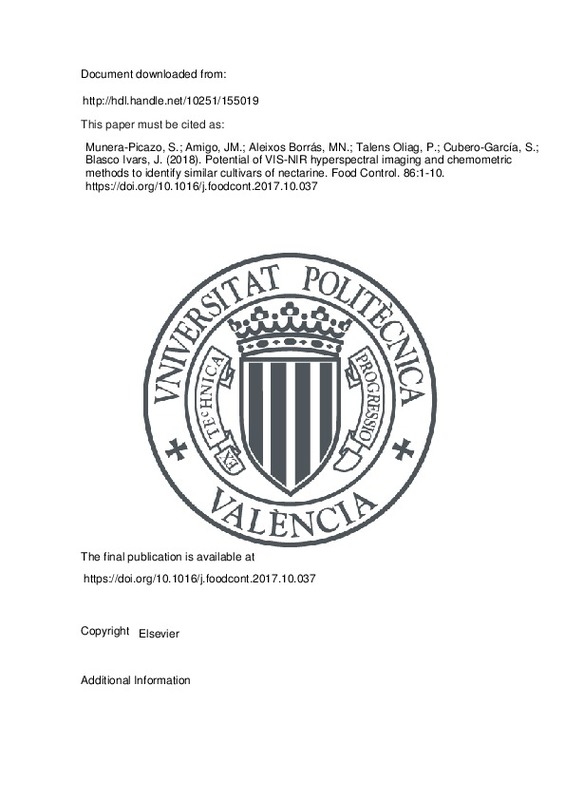JavaScript is disabled for your browser. Some features of this site may not work without it.
Buscar en RiuNet
Listar
Mi cuenta
Estadísticas
Ayuda RiuNet
Admin. UPV
Potential of VIS-NIR hyperspectral imaging and chemometric methods to identify similar cultivars of nectarine
Mostrar el registro sencillo del ítem
Ficheros en el ítem
| dc.contributor.author | Munera-Picazo, S.
|
es_ES |
| dc.contributor.author | Amigo,Jose Manuel
|
es_ES |
| dc.contributor.author | Aleixos Borrás, María Nuria
|
es_ES |
| dc.contributor.author | Talens Oliag, Pau
|
es_ES |
| dc.contributor.author | Cubero-García, Sergio
|
es_ES |
| dc.contributor.author | BLASCO IVARS, JOSE
|
es_ES |
| dc.date.accessioned | 2020-11-13T04:33:19Z | |
| dc.date.available | 2020-11-13T04:33:19Z | |
| dc.date.issued | 2018-04 | es_ES |
| dc.identifier.issn | 0956-7135 | es_ES |
| dc.identifier.uri | http://hdl.handle.net/10251/155019 | |
| dc.description.abstract | [EN] Product inspection is essential to ensure good quality and to avoid fraud. New nectarine cultivars with similar external appearance but different physicochemical properties may be mixed in the market, causing confusion and rejection among consumers, and consequently affecting sales and prices. Hyperspectral reflectance imaging in the range of 450¿1040 nm was studied as a non-destructive method to differentiate two cultivars of nectarines with a very similar appearance but different taste. Partial least squares discriminant analysis (PLS-DA) was used to develop a prediction model to distinguish intact fruits of the cultivars using pixel-wise and mean spectrum approaches, and then the model was projected onto the complete surface of fruits allowing visual inspection. The results indicated that mean spectrum of the fruit was the most accurate method, a correct discrimination rate of 94% being achieved. Wavelength selection reduced the dimensionality of the hyperspectral images using the regression coefficients of the PLS-DA model. An accuracy of 96% was obtained by using 14 optimal wavelengths, whereas colour imaging and a trained inspection panel achieved a rate of correct classification of only 57% of the fruits. | es_ES |
| dc.description.sponsorship | This work was partially funded by INIA and FEDER funds through project RTA2015-00078-00-00. Sandra Munera thanks INIA for the FPI-INIA grant num. 43 (CPR2014-0082), partially supported by European Union FSE funds. The authors wish to thank Fruits de Ponent (Lleida) for providing the fruit. | es_ES |
| dc.language | Inglés | es_ES |
| dc.publisher | Elsevier | es_ES |
| dc.relation.ispartof | Food Control | es_ES |
| dc.rights | Reserva de todos los derechos | es_ES |
| dc.subject | Stone fruit | es_ES |
| dc.subject | Quality control | es_ES |
| dc.subject | Cultivar discrimination | es_ES |
| dc.subject | Non-destructive | es_ES |
| dc.subject | PLS-DA | es_ES |
| dc.subject | Colour analysis | es_ES |
| dc.subject | Hyperspectral image | es_ES |
| dc.subject.classification | TECNOLOGIA DE ALIMENTOS | es_ES |
| dc.subject.classification | EXPRESION GRAFICA EN LA INGENIERIA | es_ES |
| dc.title | Potential of VIS-NIR hyperspectral imaging and chemometric methods to identify similar cultivars of nectarine | es_ES |
| dc.type | Artículo | es_ES |
| dc.identifier.doi | 10.1016/j.foodcont.2017.10.037 | es_ES |
| dc.relation.projectID | info:eu-repo/grantAgreement/MINECO//RTA2015-00078-00-00/ES/Sistemas no destructivos para la determinación automática de la calidad interna de frutas en línea utilizando métodos ópticos e información espectral/ | es_ES |
| dc.relation.projectID | info:eu-repo/grantAgreement/INIA//CPR2014-0082/ | es_ES |
| dc.rights.accessRights | Abierto | es_ES |
| dc.contributor.affiliation | Universitat Politècnica de València. Departamento de Tecnología de Alimentos - Departament de Tecnologia d'Aliments | es_ES |
| dc.contributor.affiliation | Universitat Politècnica de València. Departamento de Ingeniería Gráfica - Departament d'Enginyeria Gràfica | es_ES |
| dc.contributor.affiliation | Universitat Politècnica de València. Departamento de Mecanización y Tecnología Agraria - Departament de Mecanització i Tecnologia Agrària | es_ES |
| dc.description.bibliographicCitation | Munera-Picazo, S.; Amigo, JM.; Aleixos Borrás, MN.; Talens Oliag, P.; Cubero-García, S.; Blasco Ivars, J. (2018). Potential of VIS-NIR hyperspectral imaging and chemometric methods to identify similar cultivars of nectarine. Food Control. 86:1-10. https://doi.org/10.1016/j.foodcont.2017.10.037 | es_ES |
| dc.description.accrualMethod | S | es_ES |
| dc.relation.publisherversion | https://doi.org/10.1016/j.foodcont.2017.10.037 | es_ES |
| dc.description.upvformatpinicio | 1 | es_ES |
| dc.description.upvformatpfin | 10 | es_ES |
| dc.type.version | info:eu-repo/semantics/publishedVersion | es_ES |
| dc.description.volume | 86 | es_ES |
| dc.relation.pasarela | S\355923 | es_ES |
| dc.contributor.funder | Instituto Nacional de Investigación y Tecnología Agraria y Alimentaria | es_ES |
| dc.contributor.funder | European Commission | es_ES |
| dc.contributor.funder | Instituto Nacional de Investigación y Tecnología Agraria y Alimentaria | es_ES |
| dc.contributor.funder | Ministerio de Economía y Competitividad | es_ES |







![[Cerrado]](/themes/UPV/images/candado.png)

